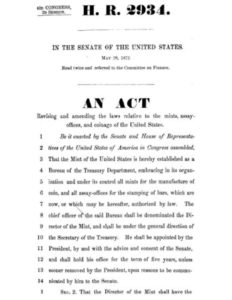What is the Coinage Act of 1873?

Legislation that amended the laws initially established by the Coinage Act of 1792 as it related to the U.S. Mint, and Assay offices. It changed laws that originally set the U.S. on a silver standard and moved the country to the gold standard.
Since the 1792 act, the U.S. operated on a monetary system that was based on the value of both silver and gold, bimetallism. However, the system proved to be unstable over a long period due to price fluctuations of gold and silver in world markets. These fluctuations meant that the U.S. struck gold and silver coins were rarely in circulation, and most coins exported to other countries.
While the primary objective of the new bill was to address the U.S. Mint’s processes and structure, Congress was also acting on recommendations made by its foreign counterparts at the 1876 International Monetary Conference in Paris that would see most counties moving to a gold standard, a direction that would ultimately help standardize global currency. Some of the amendments included establishing a fund that allowed for bullion depositors to be paid without waiting for their metal to be minted; and adjusting the value between equivalent weights of silver and gold which increased circulation of silver and gold coins within the United States.
When the act was signed into law it ultimately ended bimetallism in the United States, by demonetizing silver. However, Congress in debating the bill neglected to adequately discuss amongst themselves the impact of moving the country to the gold standard. It also neglected to inform the public before the acts passing, that silver would no longer be struck as legal tender. For many bullion holders, this created major economic hardships, since their silver could no longer be used as legal tender the moment the bill was signed. This part of the act was so contentious that it became known as the crime of 1873. This pushback was undergirded by newspaper articles asserting bimetallism as constitutional, by congressional debates decrying the move to the gold standard, and a free silver movement led by a Democratic presidential hopeful named William Jennings Bryan. The act ultimately ushered in a depression that lasted for almost a decade.
See “Fourth Coinage Act”
Back to All Terms
